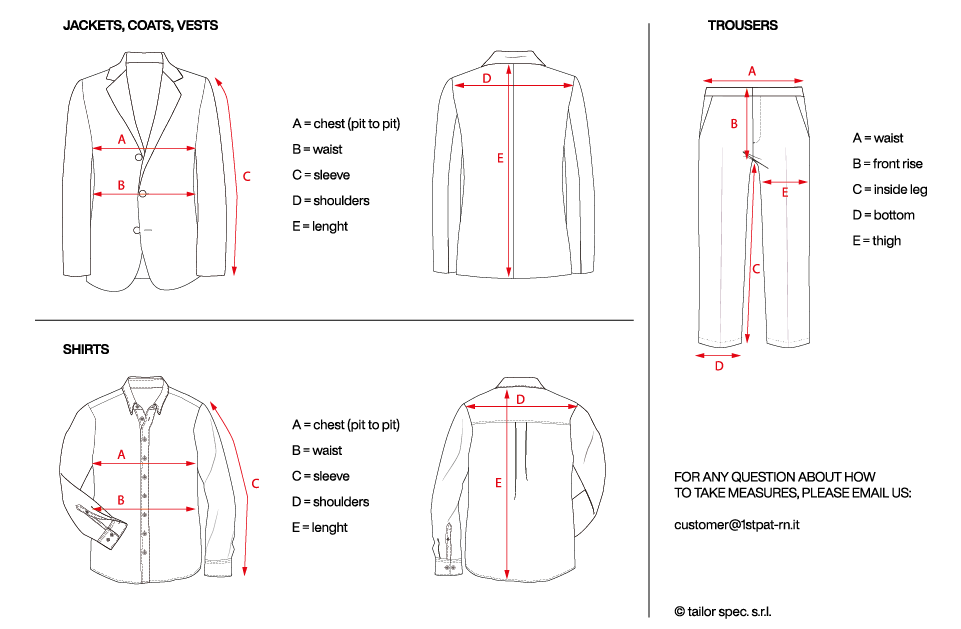NOTES ON SIZING
First of all, an important note that we recommend that you keep in mind:
Size and fit are two very different factors.
The size is based on a numerical concept and for this reason, the measurements are indicated under each product.
The fit is based on the style of the designer and the style of the products.
Not all sizes are necessarily the same: for example, a fit in size M for a “regular” design, will be different from a fit in size M, for a “slim” design.
For this, the best thing is to always consult the size tables and make a comparison of key points: chest, waist, and sleeves.
We have chosen to give clear and precise measurement tables compared to the vague and generic measurement tables of some sites, we want to reduce the cost of returns that you have to bear and avoid the goods moving back and forth polluting the environment.
We remind you that the size of the outerwear and jacket must be taken by spreading the garment very well, and flat, and the buttonholes must be at their maximum extension.
The waist of the trousers must be measured on the back always keeping the garment flat.
If you have any doubts, write to us.
If you need support, just write, we want your purchase to satisfy you 100%: below, you could read more info too.
All the sizes on the measurement tables are expressed in cm.
The first step in purchasing our products is knowing how to take measurements because this aspect is crucial to understanding if a product fits the way you want: to do this we have created a diagram that helps you in taking the correct measurements for each garment.
It is noted that the fabric plays a significant role in the perception of a garment’s fit. For example, models such as the Garnett Chino, the Labourer, the Tipo 3, or the Task are all cut from the same fit, with variations in details (pockets, etc.). However, differences in fabric—whether stiffer or softer, heavier or lighter, suited for summer or winter—can make them feel as if they have different fits when worn. This is why, in making your selection, the garment’s measurements, along with the stated and allowed tolerances, should always serve as your reference.
The same applies to jackets and vests.
Please follow only this method and if you have any doubts, contact us.
1ST PAT-RN’s style is comfortable and relaxed, interpreted through fabrics that best pair with the design of our garments.
Our fits have become the icons of the brand and we have a high grade of satisfaction from our customers.
Often the same styles are worn without distinction of gender and we love this freedom of interpretation which has, in some ways, become our calling card.
We believe that everyone should be free to wear the garments that they love, without being rigidly tied to sizes or predefined measurements. That is why we created a lookbook of the clothing when it is worn – which you can browse on our site – where we have represented our take on our style: you can get inspiration from those images to better understand the fit of our products.
The lookbook shows some examples of fit and styling, the models are about 185 cm. in height, and generally, they wear LARGE tops and MEDIUM bottoms, while for the SERGE COTTON/HEMP all the pictures show LARGE size products.
The girl is 170 cm. and she wears SMALL
However, every product on the site comes with a measurement table based on the measurements of the finished garments from a few samples of the same style and model taken at the quality control stage.
We are extremely attentive to the measurements of the garments, yet despite this, due to the specific tolerance in the textile sector, we can estimate in 1,5 cm. plus or less.
The hand-made manufacturing of clothing, the type of fabric, the treatment, the consistency of the fabric, and the dye, could give slight variations.
Of course, if you look for a bespoke garment, please check for a local tailor and you will find the best solution for your needs.
Always try on garments that you already own, comparing the measurements with our own, and you will be able to get a better idea if our pieces will fit your body to avoid mistakes that will incur costs for return shipments, and so on.
We, therefore, invite you to always read the size charts, but above all to understand our product philosophy regarding fit: the first step towards the great satisfaction of wearing one of our garments.
If you have any doubts about measurements and the fit of products and need more information, please write to customer@utilityspecifications.it
Thanks for taking the time to read this

